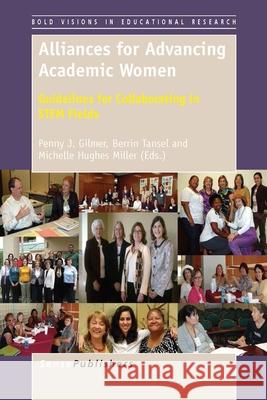Alliances for Advancing Academic Women » książka
Alliances for Advancing Academic Women
ISBN-13: 9789462096035 / Angielski / Twarda / 2014 / 238 str.
Alliances for Advancing Academic Women
ISBN-13: 9789462096035 / Angielski / Twarda / 2014 / 238 str.
(netto: 421,88 VAT: 5%)
Najniższa cena z 30 dni: 425,63
ok. 30 dni roboczych.
Darmowa dostawa!
This unique book provides important guidelines and examples of ways STEM (e.g., science, technology, engineering, and mathematics) faculty and administration can collaborate towards goals of recruiting, mentoring, and promoting leadership to academic women faculty. Based on the experiences of faculty across five Florida universities, including one national laboratory, each chapter highlights one aspect of a multi-institutional collaboration on an NSF ADVANCE-PAID grant dedicated to achieving these three goals. Highlighting the importance of coordination, integration, and flexibility, each chapter details strategies and challenges of establishing a multi-site collaboration, assessing climate in STEM departments, addressing differential institutional readiness and infrastructure, and implementing change. The authors suggest ways to build on intrainstitutional strengths through interinstitutional activities, including shared workshops, research, and materials. Separate chapters focus on recruiting women into STEM departments, mentoring women faculty, and providing leadership opportunities to women. A theoretical chapter includes Cultural historical activity theory as a lens for examining the alliances' activities and evaluation data. Other chapters present research on women STEM faculty, contributing insights about STEM women's sense of isolation. Chapters include a reflective metalogue written by a social scientist. The book closes with lessons learned from this collaboration.
This unique book provides important guidelines and examples of ways STEM (e.g., science, technology, engineering, and mathematics) faculty and administration can collaborate towards goals of recruiting, mentoring, and promoting leadership to academic women faculty. Based on the experiences of faculty across five Florida universities, including one national laboratory, each chapter highlights one aspect of a multi-institutional collaboration on an NSF ADVANCE-PAID grant dedicated to achieving these three goals. Highlighting the importance of coordination, integration, and flexibility, each chapter details strategies and challenges of establishing a multi-site collaboration, assessing climate in STEM departments, addressing differential institutional readiness and infrastructure, and implementing change. The authors suggest ways to build on intrainstitutional strengths through interinstitutional activities, including shared workshops, research, and materials. Separate chapters focus on recruiting women into STEM departments, mentoring women faculty, and providing leadership opportunities to women. A theoretical chapter includes Cultural historical activity theory as a lens for examining the alliances activities and evaluation data. Other chapters present research on women STEM faculty, contributing insights about STEM womens sense of isolation. Chapters include a reflective metalogue written by a social scientist. The book closes with lessons learned from this collaboration.











